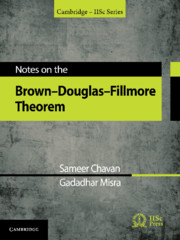Refine search
Actions for selected content:
8126 results in Fluid dynamics and solid mechanics
7 - Nonlinear, Nonparallel Effects on Receptivity, Instability, and Transition
-
- Book:
- Transition to Turbulence
- Published online:
- 16 February 2021
- Print publication:
- 05 August 2021, pp 212-247
-
- Chapter
- Export citation
A NOTE ON THE AXISYMMETRIC DIFFUSION EQUATION
- Part of
-
- Journal:
- The ANZIAM Journal / Volume 63 / Issue 3 / July 2021
- Published online by Cambridge University Press:
- 21 July 2021, pp. 333-341
-
- Article
- Export citation
OPTIMAL PORTFOLIO AND CONSUMPTION FOR A MARKOVIAN REGIME-SWITCHING JUMP-DIFFUSION PROCESS
- Part of
-
- Journal:
- The ANZIAM Journal / Volume 63 / Issue 3 / July 2021
- Published online by Cambridge University Press:
- 21 July 2021, pp. 308-332
-
- Article
- Export citation

Notes on the Brown-Douglas-Fillmore Theorem
-
- Published online:
- 30 June 2021
- Print publication:
- 07 October 2021
ANZ VOLUME 63 ISSUE 1 COVER AND BACK MATTER
-
- Journal:
- The ANZIAM Journal / Volume 63 / Issue 1 / January 2021
- Published online by Cambridge University Press:
- 30 June 2021, pp. b1-b6
-
- Article
-
- You have access
- Export citation
ANZ VOLUME 63 ISSUE 1 COVER AND FRONT MATTER
-
- Journal:
- The ANZIAM Journal / Volume 63 / Issue 1 / January 2021
- Published online by Cambridge University Press:
- 30 June 2021, pp. f1-f2
-
- Article
-
- You have access
- Export citation
ASYMMETRICAL CELL DIVISION WITH EXPONENTIAL GROWTH
- Part of
-
- Journal:
- The ANZIAM Journal / Volume 63 / Issue 1 / January 2021
- Published online by Cambridge University Press:
- 04 June 2021, pp. 70-83
-
- Article
- Export citation
ANALYSIS OF CELL TRANSMISSION MODEL FOR TRAFFIC FLOW SIMULATION WITH APPLICATION TO NETWORK TRAFFIC
- Part of
-
- Journal:
- The ANZIAM Journal / Volume 63 / Issue 1 / January 2021
- Published online by Cambridge University Press:
- 18 May 2021, pp. 84-99
-
- Article
- Export citation
13 - System Search and Optimization
-
- Book:
- Duct Acoustics
- Published online:
- 11 May 2021
- Print publication:
- 13 May 2021, pp 533-551
-
- Chapter
- Export citation
10 - Modeling of Ducted Acoustic Sources
-
- Book:
- Duct Acoustics
- Published online:
- 11 May 2021
- Print publication:
- 13 May 2021, pp 438-473
-
- Chapter
- Export citation
Copyright page
-
- Book:
- Duct Acoustics
- Published online:
- 11 May 2021
- Print publication:
- 13 May 2021, pp iv-iv
-
- Chapter
- Export citation
5 - Resonators, Expansion Chambers and Silencers
-
- Book:
- Duct Acoustics
- Published online:
- 11 May 2021
- Print publication:
- 13 May 2021, pp 173-237
-
- Chapter
- Export citation
Appendix B - Acoustic Properties of Rigid-Frame Fibrous Materials
-
- Book:
- Duct Acoustics
- Published online:
- 11 May 2021
- Print publication:
- 13 May 2021, pp 561-566
-
- Chapter
- Export citation
6 - Multi-Modal Sound Propagation in Ducts
-
- Book:
- Duct Acoustics
- Published online:
- 11 May 2021
- Print publication:
- 13 May 2021, pp 238-325
-
- Chapter
- Export citation
12 - Measurement Methods
-
- Book:
- Duct Acoustics
- Published online:
- 11 May 2021
- Print publication:
- 13 May 2021, pp 501-532
-
- Chapter
- Export citation
Contents
-
- Book:
- Duct Acoustics
- Published online:
- 11 May 2021
- Print publication:
- 13 May 2021, pp vii-xvi
-
- Chapter
- Export citation
Appendix A - Basic Equations of Fluid Motion
-
- Book:
- Duct Acoustics
- Published online:
- 11 May 2021
- Print publication:
- 13 May 2021, pp 552-560
-
- Chapter
- Export citation
Appendix C - Impedance of Compact Apertures
-
- Book:
- Duct Acoustics
- Published online:
- 11 May 2021
- Print publication:
- 13 May 2021, pp 567-578
-
- Chapter
- Export citation
2 - Introduction to Acoustic Block Diagrams
-
- Book:
- Duct Acoustics
- Published online:
- 11 May 2021
- Print publication:
- 13 May 2021, pp 23-58
-
- Chapter
- Export citation
Appendices
-
- Book:
- Duct Acoustics
- Published online:
- 11 May 2021
- Print publication:
- 13 May 2021, pp 552-578
-
- Chapter
- Export citation

